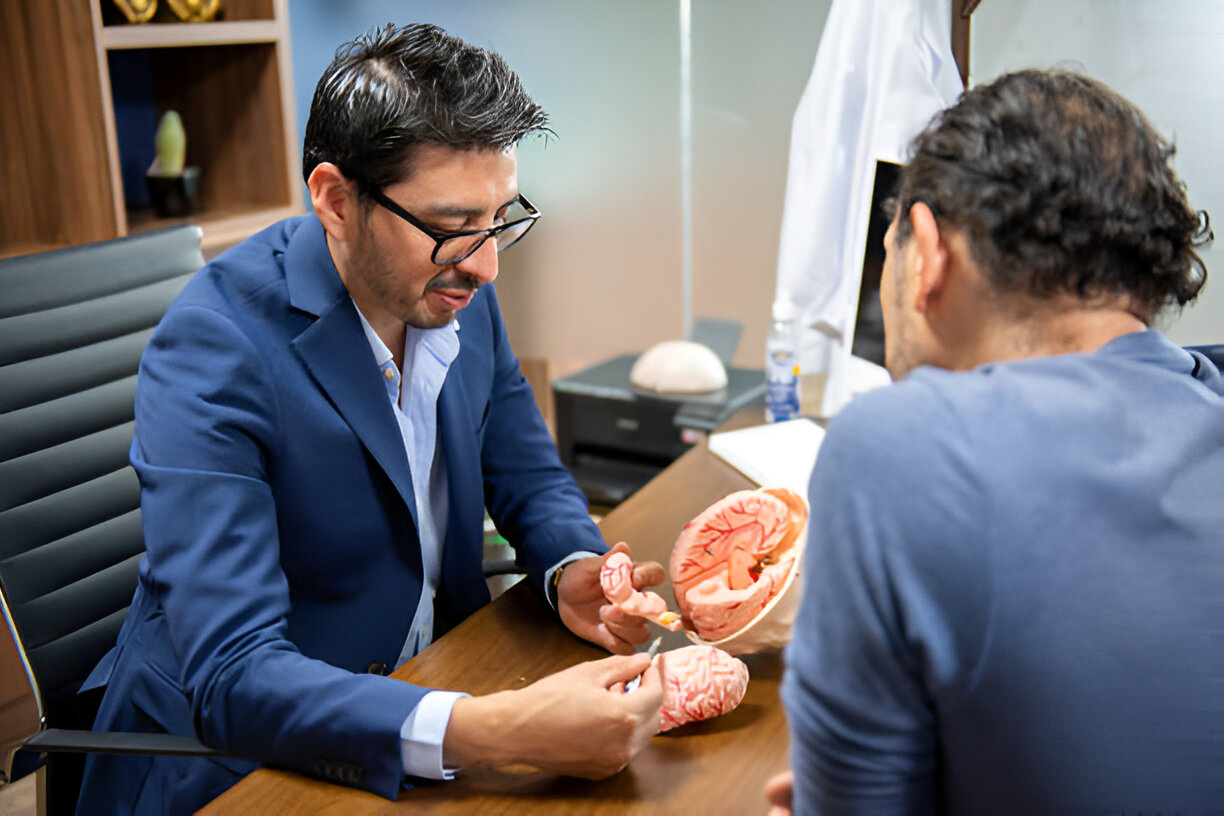




Neuro Endovascular surgery is a minimally invasive procedure that uses a pin hole with a small needle puncture to treat cerebrovascular diseases or vascular conditions. This approach reduces tissue damage and speeds up recovery time, enabling patients to resume normal activities more quickly.

During endovascular surgery, the surgeon inserts a micro wire catheter into a blood vessel, often in the groin,threads it through the vascular system to the area of concern. The surgeon uses imaging technology to guide the procedure, enabling precise treatment of conditions like aneurysms or blockages. Techniques such as thrombolytic therapy, coiling, and stenting are used to resolve the issue without the need for large incisions.
Endovascular surgery is performed by highly specialized neurosurgeons or neuroradiologists trained in both neurosurgery and radiology. These healthcare providers undergo rigorous training, including residencies and fellowship programs, to develop expertise in interventional neuroradiology and neurointerventional surgery. The multidisciplinary team approach at Kauvery Hospital ensures that each patient receives comprehensive, personalized care from experts in the field.

Kauvery Hospital is a leading destination for specialised and advanced endovascular surgery. We offer a wide range of effective treatment options for various vascular conditions through minimally invasive techniques. With a dedicated team of neurosurgeons and interventional radiologists, we combine expertise and cutting-edge technology to deliver exceptional care, improving patient outcomes and recovery times.
Endovascular surgery is often recommended for patients with neurological issues that involve blood vessels, including brain aneurysms, blood clots in brain arteries, and blockages in carotid arteries. This procedure is ideal for patients needing treatment for conditions that may otherwise require open surgery but can be managed with less invasive techniques, reducing risks,bleeding and recovery time.


Endovascular surgery includes several procedures aimed at treating neurological and vascular conditions:
A treatment that dissolves blood clots in brain arteries to restore blood flow and minimize stroke damage.
A minimally invasive procedure to remove clots from brain arteries, restoring normal circulation and reducing stroke effects.
A technique to treat brain aneurysms by placing coils inside the aneurysm, preventing blood flow and rupture.
Opens narrowed carotid arteries and places a stent to maintain proper blood flow to the brain.
Evaluates blood flow in the brain through radiological imaging.
A diagnostic procedure using imaging to evaluate blood flow and detect abnormalities in the brain’s arteries.
Thrombectomy procedure remove blood clots from arteries, restoring circulation and improving stroke outcomes.
Blocks abnormal blood vessels to prevent bleeding or reduce blood supply to tumors. An AVM embolisation or an AVM embolisation procedure and tumour embolisation or a tumour embolisation procedure are the most common ones.
Removes plaque buildup from arteries, improving blood flow and reducing the risk of vascular complications.
Aneurysm coiling involves inserting coils into an aneurysm to block blood flow and prevent rupture.
Flow diversion uses a specialized stent to redirect blood flow away from a brain aneurysm, promoting its healing.
Tumour embolisation blocks blood supply to a tumor by injecting materials into the feeding vessels, shrinking the tumor or preparing it for surgery.
Dural/Pial A.V.F embolisation involves blocking abnormal connections between arteries and veins in the brain's dura or pia mater to restore normal blood flow.
Carotid cavernous fistula repair involves sealing an abnormal connection between the carotid artery and cavernous sinus to restore normal circulation.
AVM treatment includes endovascular embolisation, surgery, or radiosurgery to correct the abnormal connections between arteries and veins.
Venous procedures, such as venous sinus stenting, relieve headaches and reduce ICP by improving blood flow in the brain's venous system.
Inserts a stent to keep arteries open, preventing further blockages. One of the stents is a flow diverter stent placed within the artery, reducing the risk of rupture of blockages.


Endovascular surgery offers high-precision imaging of your blood vessels, enabling accurate diagnosis of vascular issues.

(Angioplasty or stent placement) Endovascular surgery is a minimally invasive procedure with a short recovery time, allowing for a quick return to daily life.

The surgery provides detailed imaging that guides targeted interventions, ensuring precise treatment.

Endovascular surgery allows for customised treatment plans based on your specific vascular condition.

The procedure offers real-time monitoring of vascular health, aiding in effective management.

Endovascular surgery at Kauvery Hospital is conducted using state-of-the-art technology, ensuring accurate diagnosis and effective management of vascular conditions. Our advanced techniques prioritise precision, patient comfort, and safety.
A thorough evaluation is conducted to ensure patient readiness.
Detailed explanation:
Before undergoing endovascular surgery, patients are required to undergo a comprehensive pre-operative assessment.
This includes a physical examination, imaging studies like angiograms or CT scans, and blood tests to evaluate the patient's overall health and the extent of the vascular issue.
The surgeon will review the patient's medical history, including any previous surgeries or existing conditions like diabetes or hypertension, which might impact the procedure.
Based on this assessment, the surgical team creates a customized plan, including the selection of appropriate devices, such as stents or coils, to address the specific vascular problem.
The surgeon uses hair size wires & catheters to navigate through the blood vessels.
Detailed explanation:
Endovascular surgery is performed using a catheter—a thin, flexible tube—that is carefully inserted through a small incision, typically in the groin, arm, or leg.
The surgeon guides the catheter through the blood vessels using real-time imaging technology, such as fluoroscopy, to reach the site of the vascular issue.
Depending on the condition being treated, the surgeon may deploy a stent to open a narrowed artery, place a coil to block off an aneurysm, or perform angioplasty to restore normal blood flow.
This minimally invasive approach allows for precise treatment with minimal disruption to surrounding tissues.
Patients receive close monitoring and follow-up.
Detailed explanation:
After the endovascular procedure is completed, patients are transferred to a recovery area where they are closely monitored for several hours.
Vital signs such as heart rate, blood pressure, and oxygen levels are continuously checked to ensure stability. The surgical site is also observed for any signs of bleeding or infection.
Depending on the complexity of the procedure and the patient's overall health, they may be discharged the same day or after a short hospital stay. Patients are typically advised to avoid strenuous activities for a few days and to follow specific post-operative instructions to promote healing.
Follow-up appointments are scheduled to monitor the success of the procedure and to manage any potential complications.
Endovascular surgery at Kauvery Hospital is conducted using state-of-the-art technology, ensuring accurate diagnosis and effective management of vascular conditions. Our advanced techniques prioritise precision, patient comfort, and safety.
A thorough evaluation is conducted to ensure patient readiness.
Detailed explanation:
Before undergoing endovascular surgery, patients are required to undergo a comprehensive pre-operative assessment.
This includes a physical examination, imaging studies like angiograms or CT scans, and blood tests to evaluate the patient's overall health and the extent of the vascular issue.
The surgeon will review the patient's medical history, including any previous surgeries or existing conditions like diabetes or hypertension, which might impact the procedure.
Based on this assessment, the surgical team creates a customized plan, including the selection of appropriate devices, such as stents or coils, to address the specific vascular problem.
The surgeon uses hair size wires & catheters to navigate through the blood vessels.
Detailed explanation:
Endovascular surgery is performed using a catheter—a thin, flexible tube—that is carefully inserted through a small incision, typically in the groin, arm, or leg.
The surgeon guides the catheter through the blood vessels using real-time imaging technology, such as fluoroscopy, to reach the site of the vascular issue.
Depending on the condition being treated, the surgeon may deploy a stent to open a narrowed artery, place a coil to block off an aneurysm, or perform angioplasty to restore normal blood flow.
This minimally invasive approach allows for precise treatment with minimal disruption to surrounding tissues.
Patients receive close monitoring and follow-up.
Detailed explanation:
After the endovascular procedure is completed, patients are transferred to a recovery area where they are closely monitored for several hours.
Vital signs such as heart rate, blood pressure, and oxygen levels are continuously checked to ensure stability. The surgical site is also observed for any signs of bleeding or infection.
Depending on the complexity of the procedure and the patient's overall health, they may be discharged the same day or after a short hospital stay. Patients are typically advised to avoid strenuous activities for a few days and to follow specific post-operative instructions to promote healing.
Follow-up appointments are scheduled to monitor the success of the procedure and to manage any potential complications.
Endovascular surgery is a minimally invasive procedure that can treat brain conditions like aneurysms, but it is not limited to brain surgery alone.
Endovascular treatment is often preferred for aneurysms due to its minimally invasive nature, quicker recovery, and reduced risk compared to traditional surgery.
